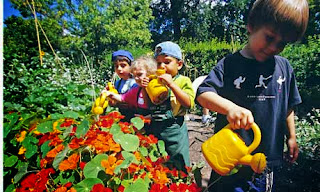John Ajak, a Lost Boy of Sudan now 32, has something in common with all North Texas gardeners, despite the vast differences between his past and the majority of ours. Ajak calls his work tending display gardens at the Dallas Arboretum his therapy. When I began to talk to him about how gardening was my therapy, too, I quickly found myself blubbering.
Was I boo-hooing because gardening, for me, is so connected to my late mother? Or because I can no longer dig in the dirt, due to a back injury three years ago?
Maybe I was moved to tears because, having read Ajak’s just-published memoir about the vicious civil war in what is now South Sudan, I knew he was separated from his mother for 25 years, each thinking the other dead. Ajak, as a boy of only 7, ran for his life for literally 14 years, dodging bullets and crocodiles, hobbling on skinned feet, starving and dehydrated, often gulping water thick with stagnation and animal feces.
Ajak’s smile is broad, brilliant and genuine, a gift freely given to a stranger. Although he has earned two graduate degrees since his 2001 resettlement by Catholic Charities, he keeps his job at the Dallas Arboretum. He will tell you proudly that he is a gardener, something like his late father, a farmer who grew cassava for food. The arboretum plants cassava, what Americans call tapioca, as a summer ornamental.
He has earned extra responsibilities at this job of 12 years, both on paper and among his colleagues. He has a knack for envisioning what a fairytale house made of pumpkins or a flower bed in the Jonsson Color Garden should look like in the end. When co-workers are stymied, they come to Ajak, saying, “You have magic hands. Make it work.”
There are many reasons Ajak calls the arboretum his therapy. There is the physical beauty of the place; hundreds of thousands visit it annually for that reason. That Ajak has a role in that beauty is salve for his inner wounds, which he kept locked inside until he decided to write Unspeakable: My Journey as a Lost Boy of Sudan.
He loves to watch children at the arboretum tumbling on the grass, squealing at squirrels, marveling at the houses made of pumpkins and flowers. Happy, content children remind him of his life before civil war, before he was hunted, before the years of a refugee camp in Kenya, when his father was alive and family mattered more than anything else.
“I feel I belong here. I feel I connect with the plants,” says Ajak, a 6-foot-7-inch man in like-new athletic shoes and an arboretum sweatshirt. “I am doing something to make the children happy. My heart is always filled with joy.”
Passage after passage in the self-published book describes the boy Ajak’s days in the brush or jungle, dodging bullets, hearing others’ screams of torture, afraid to sleep for fear of being eaten by a wild animal, and walking, always walking, in search of safety. Even after reading the words on the page, it is impossible to imagine what he and other children endured.
Ajak’s reason for writing the book is to offer the possibility of hope to others, particularly to children in Dallas, in Texas, who are poor, hungry or alone. Can anyone refute his assertion that his life today is proof that everything is possible, no matter where you come from, what you have suffered?
“If I would be able to reach any poor kid,” Ajak says, “I would be glad. I used to struggle not to talk about what I have seen. But love and suffering have no boundaries.”
Love is what Ajak focuses on now. Although he is separated from his family by continents, he budgets 50 percent of his salary to pay for the education of his seven younger siblings. The youngest of them he does not even know, yet the family bond among Dinka tribesmen is that strong. Four finished high school, a fifth has a college degree.
With the youngest about to finish college, one might think Ajak could focus on his own life now. He would like to fall in love and become a father one day, but he does not feel financially ready.
“I have not looked yet,” he says, dimpling. Instead, the Sudanese-American will put any book profits (he’s planning a sequel) toward buying school supplies for the children in the villages wracked by civil war. School, almost everywhere, is a chalkboard under a tree, with a village volunteer as the teacher. There are no pens, pencils or paper — until Ajak gets to work on the problem.
The love shown Ajak in his life, first by his parents, later by the arboretum and other Texans, he says, compels him to give back what he can.
“Even though I have nothing to give,” he says, his eyes revealing little of what he has endured, “I give my heart.”
Like his knack for envisioning a finished project, John Ajak also has a knack for a turn of phrase. It is not from book-learning, but, again, my imagination fails to comprehend this man.
He returns our conversation to his daily joy, his job at the arboretum among the flowers.
“I’m a spring guy,” he says, mentioning the tulips and daffodils that draw hundreds of thousands to the botanical garden every March and April.
Was I boo-hooing because gardening, for me, is so connected to my late mother? Or because I can no longer dig in the dirt, due to a back injury three years ago?
Maybe I was moved to tears because, having read Ajak’s just-published memoir about the vicious civil war in what is now South Sudan, I knew he was separated from his mother for 25 years, each thinking the other dead. Ajak, as a boy of only 7, ran for his life for literally 14 years, dodging bullets and crocodiles, hobbling on skinned feet, starving and dehydrated, often gulping water thick with stagnation and animal feces.
Ajak’s smile is broad, brilliant and genuine, a gift freely given to a stranger. Although he has earned two graduate degrees since his 2001 resettlement by Catholic Charities, he keeps his job at the Dallas Arboretum. He will tell you proudly that he is a gardener, something like his late father, a farmer who grew cassava for food. The arboretum plants cassava, what Americans call tapioca, as a summer ornamental.
He has earned extra responsibilities at this job of 12 years, both on paper and among his colleagues. He has a knack for envisioning what a fairytale house made of pumpkins or a flower bed in the Jonsson Color Garden should look like in the end. When co-workers are stymied, they come to Ajak, saying, “You have magic hands. Make it work.”
There are many reasons Ajak calls the arboretum his therapy. There is the physical beauty of the place; hundreds of thousands visit it annually for that reason. That Ajak has a role in that beauty is salve for his inner wounds, which he kept locked inside until he decided to write Unspeakable: My Journey as a Lost Boy of Sudan.
He loves to watch children at the arboretum tumbling on the grass, squealing at squirrels, marveling at the houses made of pumpkins and flowers. Happy, content children remind him of his life before civil war, before he was hunted, before the years of a refugee camp in Kenya, when his father was alive and family mattered more than anything else.
“I feel I belong here. I feel I connect with the plants,” says Ajak, a 6-foot-7-inch man in like-new athletic shoes and an arboretum sweatshirt. “I am doing something to make the children happy. My heart is always filled with joy.”
Passage after passage in the self-published book describes the boy Ajak’s days in the brush or jungle, dodging bullets, hearing others’ screams of torture, afraid to sleep for fear of being eaten by a wild animal, and walking, always walking, in search of safety. Even after reading the words on the page, it is impossible to imagine what he and other children endured.
Ajak’s reason for writing the book is to offer the possibility of hope to others, particularly to children in Dallas, in Texas, who are poor, hungry or alone. Can anyone refute his assertion that his life today is proof that everything is possible, no matter where you come from, what you have suffered?
“If I would be able to reach any poor kid,” Ajak says, “I would be glad. I used to struggle not to talk about what I have seen. But love and suffering have no boundaries.”
Love is what Ajak focuses on now. Although he is separated from his family by continents, he budgets 50 percent of his salary to pay for the education of his seven younger siblings. The youngest of them he does not even know, yet the family bond among Dinka tribesmen is that strong. Four finished high school, a fifth has a college degree.
With the youngest about to finish college, one might think Ajak could focus on his own life now. He would like to fall in love and become a father one day, but he does not feel financially ready.
“I have not looked yet,” he says, dimpling. Instead, the Sudanese-American will put any book profits (he’s planning a sequel) toward buying school supplies for the children in the villages wracked by civil war. School, almost everywhere, is a chalkboard under a tree, with a village volunteer as the teacher. There are no pens, pencils or paper — until Ajak gets to work on the problem.
The love shown Ajak in his life, first by his parents, later by the arboretum and other Texans, he says, compels him to give back what he can.
“Even though I have nothing to give,” he says, his eyes revealing little of what he has endured, “I give my heart.”
Like his knack for envisioning a finished project, John Ajak also has a knack for a turn of phrase. It is not from book-learning, but, again, my imagination fails to comprehend this man.
He returns our conversation to his daily joy, his job at the arboretum among the flowers.
“I’m a spring guy,” he says, mentioning the tulips and daffodils that draw hundreds of thousands to the botanical garden every March and April.


